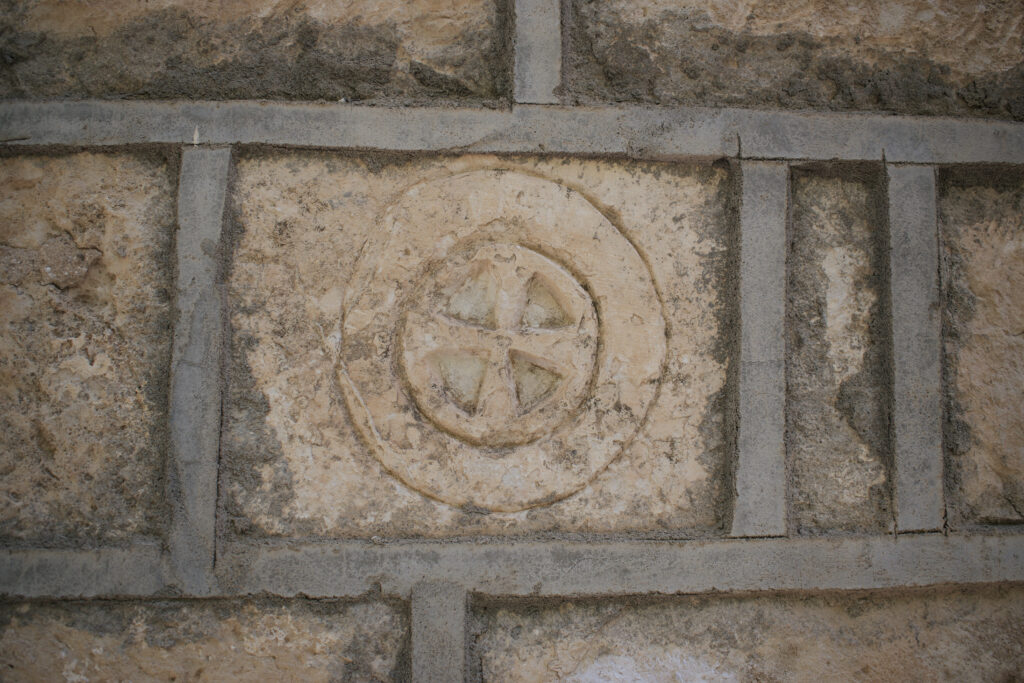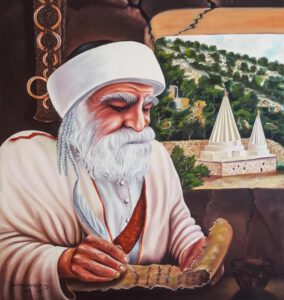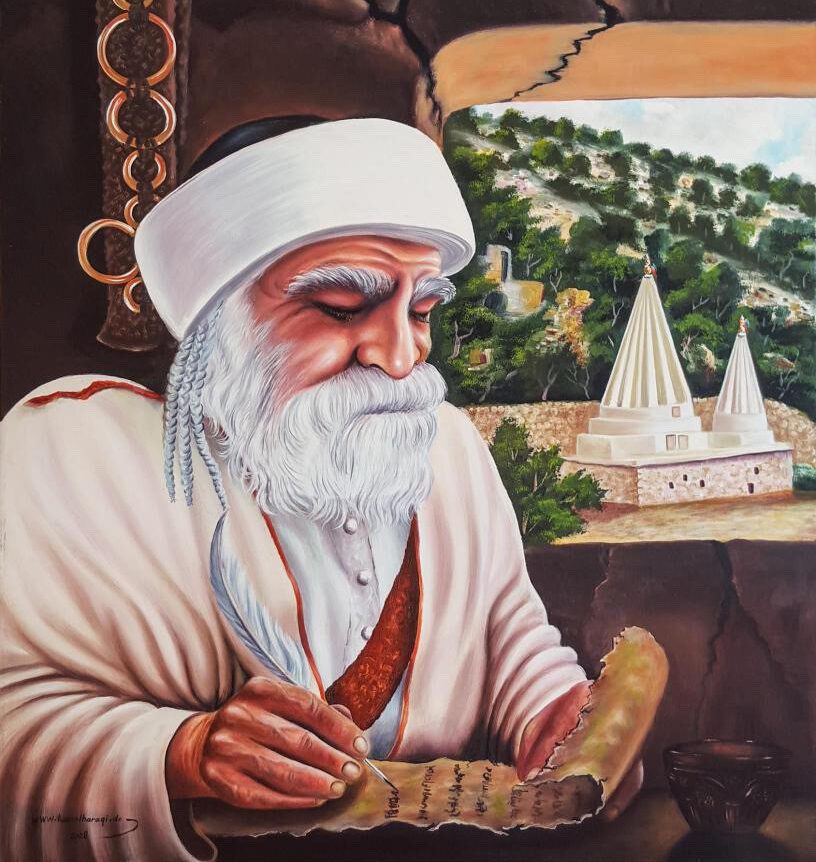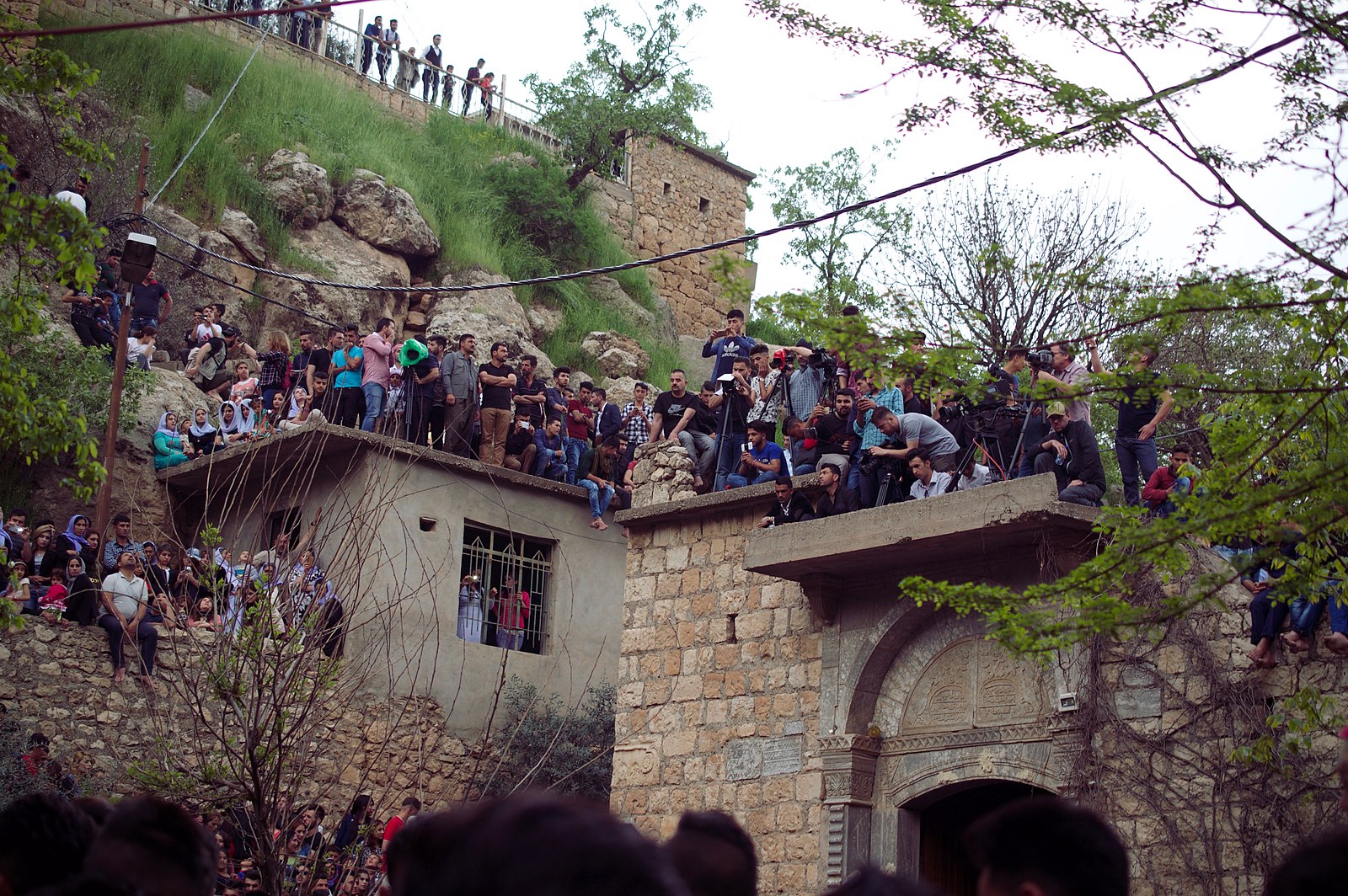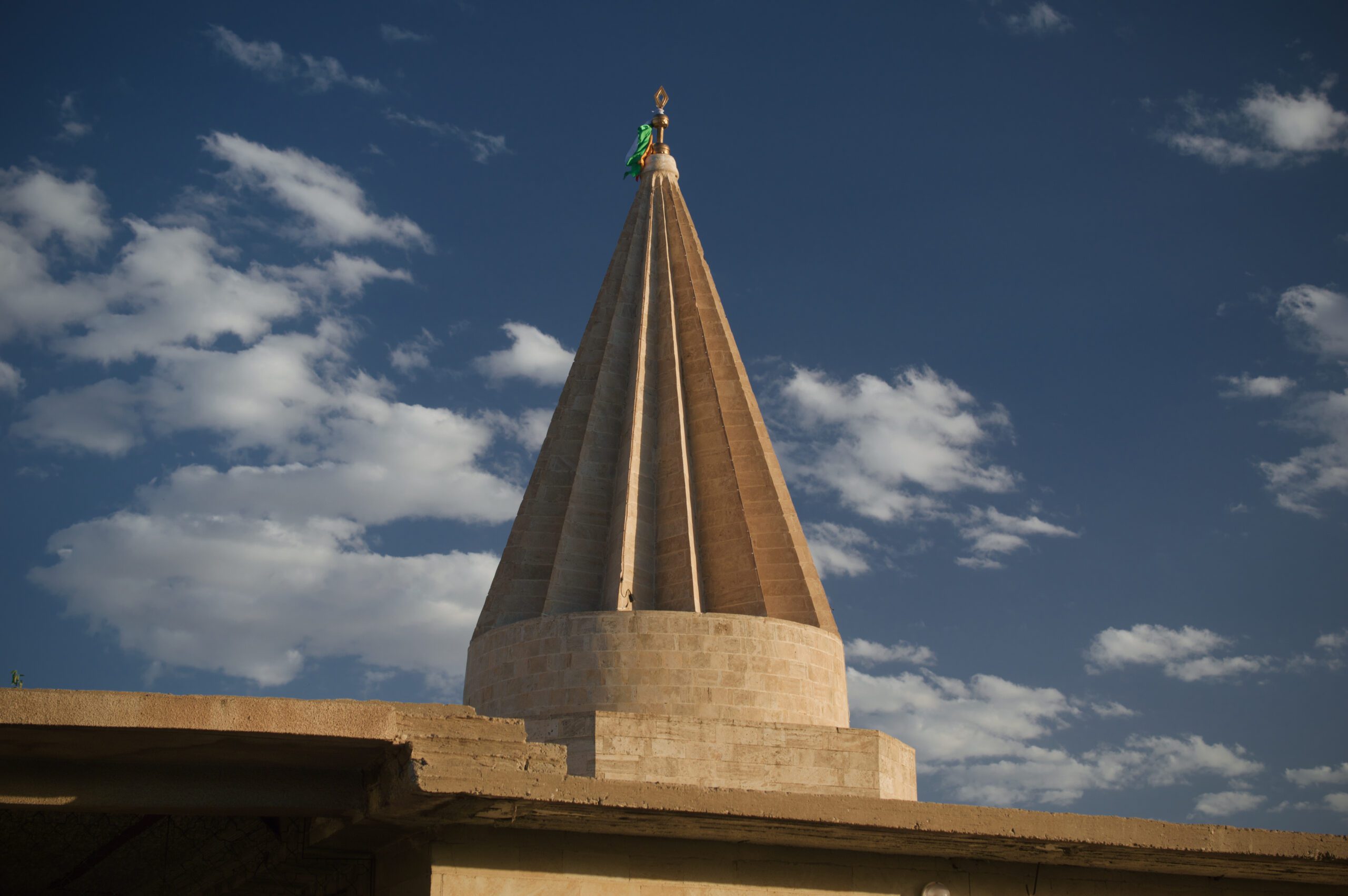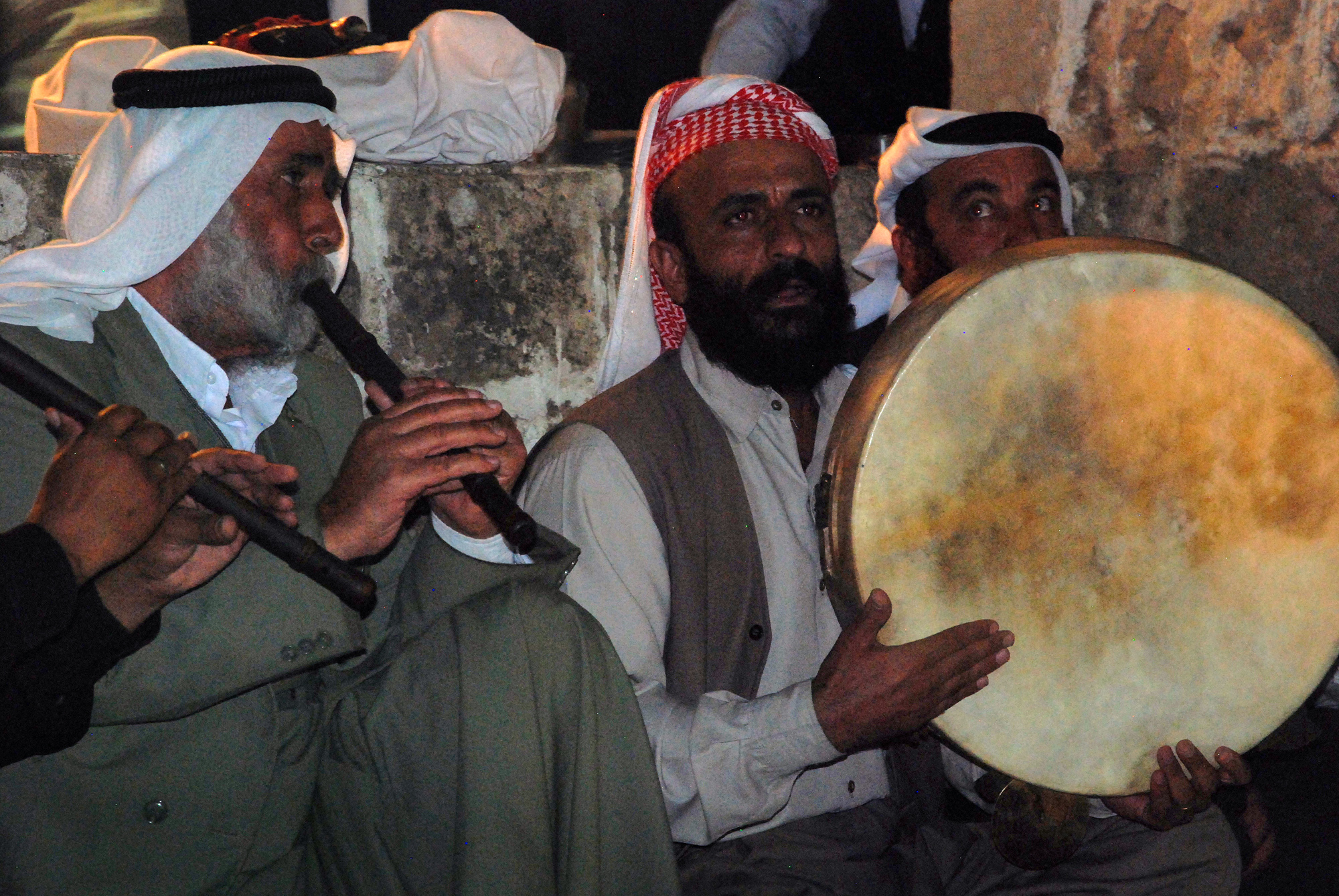The Four Elements
Air, Fire, Earth and Water are the four elements that are venerated and regarded as sacred in Ezidism. They are believed to be the source of all other natural elements in the World and the foundation of life. The role of the four elements as the foundation of life is mentioned in numerous Qewl passages. [1]Rezan Shivan Aysif, 2021, “The Role of Nature in Yezidism: Poetic Texts and Living Tradition” pp. 51-52
1. Padşê min cebare,
My King (God) is the all-powerful,
2. Ji durê efirandbû çare,
Created the four [elements] from the Pearl
3. Bayê, û axê, û avê, û narê.
Air, Earth, Water and Fire
– Qewlê Şêxûbekir
1. Av û ax, û bayî û agire.
Water and Earth, Air and Fire,
2. Dura sor ye bi xerze ji bakire,
The red Pearl contains the original seeds,
3. Çendî muxliq pê bi xatire.
It created all creatures.
– Qewlê Dura
In Ezidi tradition, God created the human body with the four elements, which is also narrated in Qewls.
1. Ax û av û agir û bay têk hincinî,
Earth, water, wind and fire were mixed,
2.Qalibê Adem pêxember pê nijinî,
The body of the prophet Adam was formed from them,
– Qewlê Zebûnî Meksûr
Moreover, the four elements are depicted in various symbols engraved on Ezidi temples, shrines and tombstones. The most famous example is the equal-armed cross (Xaç), which stands for several things, among which the four elements, the sun, the four cardinal directions (West, East, North, South) and the sacred white vest referred to as “Tok” or “Girîvan” in Kurdish. [2]Khanna Omarkhali, 2011, “Êzdiyatî: Civak, Sembol, Rîtûel û Mît” p. 92
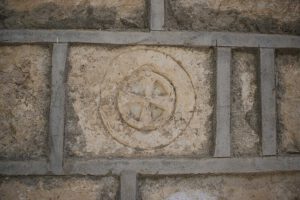
The Spiritual and Ritualistic Importance of Fire in Ezidism
Fire, or in Kurdish “Agir” and “Nar”, is a fundamental part of the Ezidi theology and way of life. It symbolises light, warmth and security owing to the fact it is an integral element for food preparation, provides light in the darkness and keeps you warm from the cold. On some occasions, Ezidis also recite prayers while facing candles, or fire altars inside some shrines as fire is also seen as the terrestrial representative of the Sun, which, due to being the celestial object considered to be the most visible symbol of God, has a crucial position within the Ezidi religion and is the primary direction to which Ezidis turn at prayer.
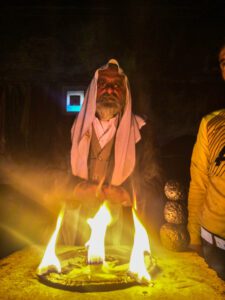
The Xudan (patron, protector, lord, master) of fire is Şêx Şems (Melik Şemsedîn), who is also the Xudan of the sun and light and is an important divine figure in Ezidism as one of the seven angels. [5]Ibid. p. 95
Role of Air in Ezidi Cosmology and Ritual
Air or Wind, referred to as “Ba” or “Bay” and also “hewa” (air) in Kurdish, is according to the Ezidi creation story one of the four primaeval elements that were contained in the Dur (pearl) before it burst. A passage from Qewlê Meha (Qewl of the Months) refers to this element as the origin of this world. [6]Ibid. p. 107
1. P’adşê min li ber hikmê xweyî rewaye,
My King (i.e God) has balance in his control,
2. Ewî deşt çêkir, rukibande ser çiyaya,
He created the plains, set mountains on it,
3. Kevna wê dinyayê baye.
The origin of this World is air.
-Qewlê Meha
Within agricultural societies, the wind was relied upon for winnowing and screening the grain from the husk on threshing floors. Thus, among the rural Ezidis, a prayer would be recited invoking Şêx Mûsê Sor, the Xudan (patron, protector, lord, master) of wind and air, praying for him to send a great deal of wind. [7]Ibid. p. 159
1. Ya Şex Mûsê Sor,
Oh Şêx Mûsê Sor,
2. Bideyî bayekî zor,
Grant a great deal of wind,
3. Dê bo te pêjin sawkêt sor.
Then we shall bake for you baked (=red) loaves.
– Invocation to Şêx Mûsê Sor for wind
The Mythological and Ceremonial Significance of Water in Ezidism
Water, in Kurdish “Av”, is also among the natural elements that play a fundamental role in the Ezidi theology and way of life. The Ezidi story of creation narrates that in the beginning, when the Pearl burst, water flowed out of it which formed a body of ocean. That is initially, the world consisted only of a vast and infinite ocean with the Eternal Tree (Dara Herherê) in its midst. Which coagulated once God cast a leaven/rennet into it. [8]Ibid. p. 87 [9]Khanna Omarkhali, 2017, “The Yezidi Religious Textual Tradition: From Oral to Written” p. 120
1. Havên avête behrê, behr pê meyanî,
[God] threw a leaven/rennet into the ocean,
2. Dexanek jê derxwenî,
Smoke appeared from it,
3. Çarde tebeq erd u ezman pê nijinî,
Fourteen spheres of the earth and the sky were formed from it,
4. Ezdanê me dur deranî,
Our God brought the Pearl out,
– Qewlê Afirîna Dinyayê
Water also plays a significant role in many Ezidi legends. According to Ezidi mythology, the two brothers, Xidir Îlyas and Xidir Nebî achieved immortality by drinking from the “Water of Life” (Ava Jîyanê/Ava Heyatê/Ava Hewanê). Xidir Îlyas and Xidir Nebî are the Xudans of water and seas. [10]Rezan Shivan Aysif, 2021, “The Role of Nature in Yezidism: Poetic Texts and Living Tradition” pp. 220-221 Whereas the Xudan of rain is Pîr Memreşan (Pîr Mehmed Reşan). [11]Ibid. pp. 99-100 In some Ezidi myths, Pîr Sinî Behrî is also presented as the Lord of the sea and son of a sea maiden. [12]Dimitri Pirbari, Nodar Mossaki & Mirza Sileman Yezdin, 2020, “A Yezidi Manuscript:—Mišūr of P’īr Sīnī Bahrī/P’īr Sīnī Dārānī, Its Study and Critical Analysis” In another famous Ezidi myth, Mîr Mih sets out on a quest to find a place where death doesn’t exist after his wife passes away. During his journey, he encounters a man who sits by the sea and throws a handful of the water out of it every day. According to the legend, this man would live up until the sea becomes dry and empty of water. [13]Bedelê Feqîr Hecî, 2002, “Bawerî û Mîtologiya Êzidîyan: Çendeha Têkist û Vekolîn”, pp. 450-474
Many sacred springs, wells and ponds are known in Ezidi regions. One of the most well-known springs is Kanîya Spî in Lalish, which plays an essential role in the Ezidi religion. It is said to have existed since pre-eternity and is believed to be the source of the leaven (Havênê Kanîya Spî) of life on earth. Additionally, newborn Ezidis are baptised (morkirin) with the water from this spring. Every Ezidi is obligated to be baptized before their death. Another well-known spring is the Zimzim spring in Lalish, where Ezidis must go to perform Selakirin after arriving in Lalish. [14]Rezan Shivan Aysif, 2021, “The Role of Nature in Yezidism: Poetic Texts and Living Tradition” pp. 96, 186-189
During droughts, Ezidis perform pilgrimages to the temple of Pîr Memêreşan and hold special ceremonies to pray for rain and a good harvest. In the past, when the rain wouldn’t come by late autumn, Ezidi villagers would perform a ceremony that involved a man dressed in scary, dirty and odd clothes parading the village while the villagers would throw water at him, believing that this manifestation would cleanse the land of evilness and allow the rains to come again. This tradition was called Hilik in Şêxan region, [15]Interview with two natives from Baadre settlement, conducted on August 2022 Hirçik in Xankê, [16]Interview with a native from Xankê settlement, conducted on August 2022 and Qeşmer in the Efrîn region. [17]Online exchanges with a native from Basufan village in Afrin, conducted on July 2022 Kurds in Jazira, Tur Abdin and Serhed, both Ezidis and Muslims alike, had a similar tradition of Bûka Baranê (Bride of the Rain), a stick figure that was dressed up in clothes, which children would then throw water at for similar purposes during droughts.
Sanctity and Importance of Earth in Ezidi Religious Life
Earth is a revered element that is of profound importance for performing sacred rites. Earth is to be respected, especially on sacred ground, therefore, spitting on earth is forbidden and taking off your shoes before walking on sacred soil in Lalish or other shrines is obligatory. In religious texts, there is a prayer regarding the veneration of the earth, called Duaya Teslîma Erdê (Prayer of Commitment to the Earth), it is also sometimes called Duaya Derwêşê Erdê, Derwêşê Erdê is in Ezidi mythology the Xudan of the earth. This prayer is recited by religious men during funerals, its content addresses committing the body of the deceased to the Xudan of the earth. [18]Rezan Shivan Aysif, 2021, “The Role of Nature in Yezidism: Poetic Texts and Living Tradition” pp. 158-159
1. Teslîmî teslîma te,
[We] entrust to you this commitment (body),
2. Tesmilî Dewrêş Erd,
Commit [the body] to Dewrêşê Erdê,
3. Ya Dewrêşê Erd,
Oh Dewrêşê Erd,
4. Avî evdî herge jin e, herge mêr e,
This being, whether a woman or a man,
5. Bixefirînî, bisetirînî.
Protect and conciliate them,
6. Sahibekî ruhê wî bikî,
Take care of his soul,
7. Berxê Êzdîda,
He/she is a lamb of Êzid,
8. Toka Tawisî Melek stûyê wî dan e,
The Tok of Tawisî Melek is on his neck.
– A variant of Duaya Teslîma Erdê
The sacred Berat orbs constitute a fundamental aspect within the Ezidi society and way of life. They are formed with a mixture of soil extracted from the Şikefta Berata (lit. Cave of Berats) in Lalish and the water of Kanîya Spî spring and then kneaded into small orbs by unmarried young girls and boys. Berats are used in various instances, including swearing oaths. For example, when two parties reach an agreement, they exchange their Berats with each other as a sign of their promise and vow to abide by the agreement. These include instances when two tribes, families or individuals who were involved in a feud agree to end their enmities and differences for the sake of peace and reconciliation, by swearing oaths on their Berats and exchanging them with each other.
Berats also play an important role in wedding rites, they are a symbol of betrothal and marriage contracts between the Bride and Groom. On the wedding day, both the Bride and Groom must have a Biraykê/Xûşka Axiretê (brother/sister of the hereafter), a bond that is concluded by drinking a water cup with a berat diluted in it. Ezidis also lay Berat on the faces of their deceased before burial to bless and purify the body as holy earth with the Berat. [19]Ibid. pp. 250-253
In Ezidi beliefs, the circular shape of the Berat symbolizes the earth. Ezidi religious texts also refer to it as the symbol of the earth and universe.
1. Heke te da êkî bexit û berat e,
If you gave someone conscience and Berat,
2. Berat nîşana erd û kinyat e,
Berat is the symbol of the earth and universe,
3. Xudê heye ew atqat e,
Swear by God, it is faith.
– Qewlê Mersûma Ceberê
References[+]
| ↑1 | Rezan Shivan Aysif, 2021, “The Role of Nature in Yezidism: Poetic Texts and Living Tradition” pp. 51-52 |
|---|---|
| ↑2 | Khanna Omarkhali, 2011, “Êzdiyatî: Civak, Sembol, Rîtûel û Mît” p. 92 |
| ↑3 | Attribution: Levi Clancy, CC0, via Wikimedia Commons |
| ↑4 | Rezan Shivan Aysif, 2021, “The Role of Nature in Yezidism: Poetic Texts and Living Tradition” pp. 207, 259 |
| ↑5 | Ibid. p. 95 |
| ↑6 | Ibid. p. 107 |
| ↑7 | Ibid. p. 159 |
| ↑8 | Ibid. p. 87 |
| ↑9 | Khanna Omarkhali, 2017, “The Yezidi Religious Textual Tradition: From Oral to Written” p. 120 |
| ↑10 | Rezan Shivan Aysif, 2021, “The Role of Nature in Yezidism: Poetic Texts and Living Tradition” pp. 220-221 |
| ↑11 | Ibid. pp. 99-100 |
| ↑12 | Dimitri Pirbari, Nodar Mossaki & Mirza Sileman Yezdin, 2020, “A Yezidi Manuscript:—Mišūr of P’īr Sīnī Bahrī/P’īr Sīnī Dārānī, Its Study and Critical Analysis” |
| ↑13 | Bedelê Feqîr Hecî, 2002, “Bawerî û Mîtologiya Êzidîyan: Çendeha Têkist û Vekolîn”, pp. 450-474 |
| ↑14 | Rezan Shivan Aysif, 2021, “The Role of Nature in Yezidism: Poetic Texts and Living Tradition” pp. 96, 186-189 |
| ↑15 | Interview with two natives from Baadre settlement, conducted on August 2022 |
| ↑16 | Interview with a native from Xankê settlement, conducted on August 2022 |
| ↑17 | Online exchanges with a native from Basufan village in Afrin, conducted on July 2022 |
| ↑18 | Rezan Shivan Aysif, 2021, “The Role of Nature in Yezidism: Poetic Texts and Living Tradition” pp. 158-159 |
| ↑19 | Ibid. pp. 250-253 |
